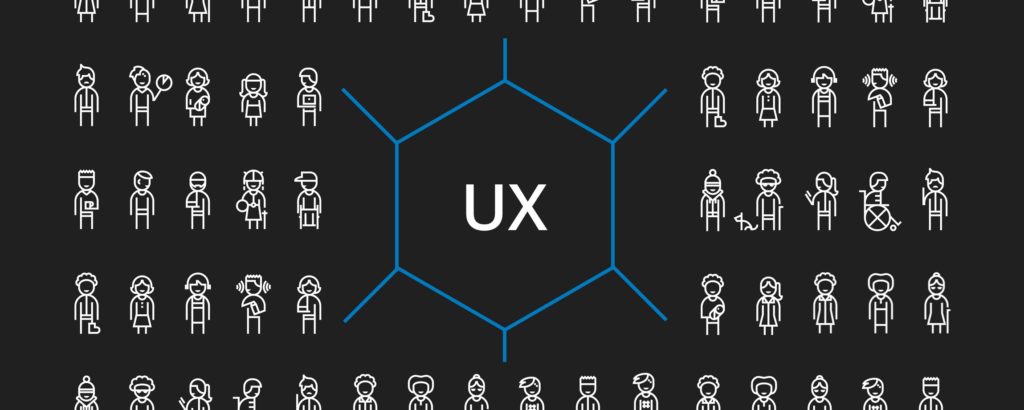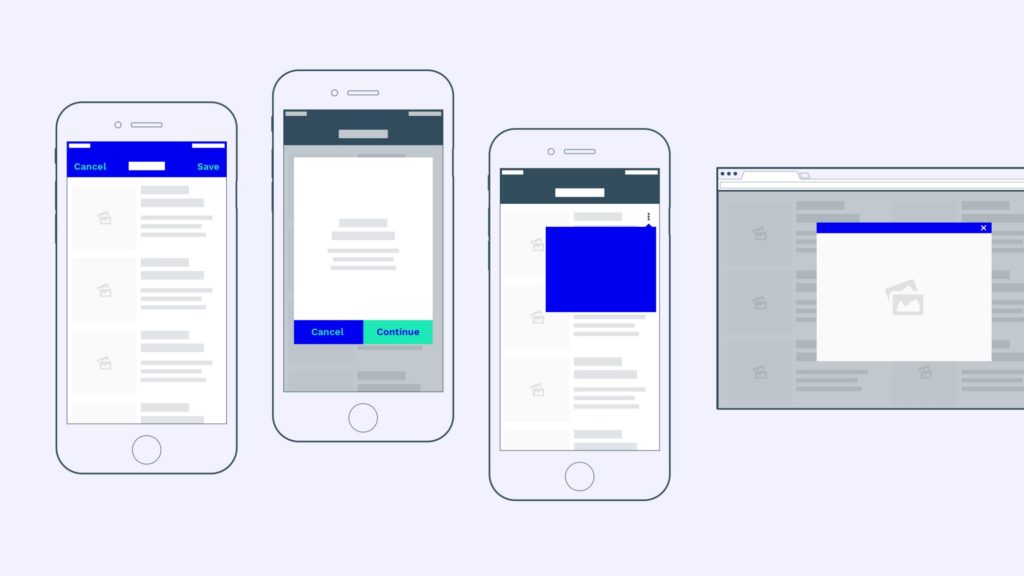BY Kelsey Bones
Where It All Started
When I started my placement with a user experience agency this year, my knowledge of UX was limited to the brief overview I had been given in the second year of my degree. I knew that as a designer, you should always aim to create a good user experience. I had encountered websites with awful user experience and wanted to make sure my designs never caused people the sort of frustration I had felt when using a confusing interface. On top of this, a good user experience is beneficial for businesses. It can increase user conversion by creating a frictionless user journey through the site or app. Increasing conversion increases profits. So the benefits are two-fold. The user is happy because they had a frictionless experience and the business is happy because it’s hitting its key performance indicators (KPI’s).
After a few months of working, I started to realise that the designs and suggestions we were making to our clients were almost always the same. We talked about having contact information always available to the user, as this increased trust in the company. Having reviews from past customers can help users feel well informed and therefore support their decision to purchase. These things all seemed logical and very straightforward. It was only after the head of UX shared an interesting infographic from digitalsynopsis.com that I started to realise that these ‘best practices’ in design, were actually based on psychological principles. And that we, as a team, we’re using psychology to influence users behaviour.
I was unsure of exactly how much these specific design patterns were influencing the user. However, I did know how much conversion usually increased after our suggestions and designs were implemented on a website. After all, our clients are the businesses, not the users, and our main goal is to help them increase conversion. At this point I put it out of my mind, it was an interesting topic but I didn’t feel the need to learn more about it.
When I came across an an interview by Adobe on Nir Eyal’s article ‘The Morality of Manipulation’ I started to think about it more. It opened my eyes to the idea that as a designer it is my job to consider the impact of my design. As Tobias Van Schnider says in his article ‘Did Hitler have great designers? Can good design be bad design?’; “The role as a designer, or even as an engineer has become more influential and powerful than ever. The work we do makes an impact and naturally brings up the discussion around ethics, responsibility, and accountability.”
I started to wonder; how much influence is acceptable for us as designers to employ on our users?
Show Me The Light
To start looking at the question ‘When Does Good User Experience Become Evil?’ You first have to understand what user experience is. The Nielsen Norman Group is one of the leading voices in UX and one of the first places to go to when learning about user experience design. nngroup.com describes user experience as ‘encompassing all aspects of the end-user’s interaction with the company, its services, and its products.’
When I started my placement one of the first things I was shown was Jakob Nielsen’s ’10 general principles for interaction design.’ These are also known as ‘heuristics’. They are taken as general guidelines on how designers can ensure the usability of their design is good and consistent. These ten heuristics are:
- Visibility of system status.
- Match between system and the real world.
- User control and freedom.
- Consistency and standards.
- Error prevention.
- Recognition rather than recall.
- Flexibility and efficiency of use.
- Aesthetic and minimalist design.
- Error recovery.
- Help and documentation.
When understood and applied correctly these principles can be the only thing a designer needs to create a good user experience.
These are very broad terms and you could write a whole essay on each of them. But I want to concentrate on a number of these guidelines, such as consistency and standards. Because not only do these heuristics fall into good usability, they also fall under the psychological principles of persuasion.
The ‘psychological principles of persuasion’ are 6 main persuasion techniques explored by the psychologist Robert Cialdini. These techniques are common themes that all fall under the umbrella of influence. Robert Cialdini outlines the 6 main principles of persuasion in ‘Influence: The Psychology of Persuasion’. These are;
1. Reciprocation. Literally, give and take. That when someone does something for you, you are indebted to them in a way that means you are more likely to agree to requests. In ‘Influence’ Cialdini reinforces the power of this principle by boldly stating that; ‘there is no human society that does not subscribe to this rule.’ Not only that but it is one of the main reasons humans have thrived. Which is a pretty big statement.
2. Commitment and Consistency. People strive to be consistent even if it means changing their opinion or choice to remain consistent. This rule is often used in conjunction with brand messaging. Brands want to portray a specific type of person who will buy their product. When this matches what a user perceives themselves to be they are more likely to purchase the product, as it reinforces their self-image.
3. Social Proof. The idea that we take and mimic cues on what to do from other people. This is a big influence in web design, you can see it when e-commerce sites post reviews, or when charities ‘suggest’ the average amount that people choose to donate.
4. Liking. We are more likely to comply with requests made by people that we like. This means both attractiveness and personality. Using attractive models or ‘aspirational’ people in your images and advertising can influence users to think they like an item more than they would if the item were to be presented by itself. Social media influencers are often utilised for this principle as well as for the Authority Principle.
5. Authority. When we are unsure of what to do (or buy) we look for authorities in that area and are more likely to believe what they have to say, simply because they are an ‘authority’. Companies have harnessed this principle through the use of advertising with the likes of ‘beauty gurus’ on YouTube (youtube.com) and using them as brand ambassadors for their company.
6. Scarcity. Literally: We want what we can’t have. Perceived scarcity of something makes us automatically put a higher value on the item. Thus making it more desirable. This is another big one used in e-commerce. Companies employ a few different methods to utilise this principle. Such as telling the user there is only ‘x’ amount left in stock or calling an item ‘limited edition’.
I want to look at how these principles are being applied in design and how common it is to use these principles in our designs. Even when we are unaware that we are doing so. How much influence do these principles actually have on users and what sort of effect can it have on things like conversion rate and transactions.
Using your powers for good
The best way to understand how these principles can be applied to our everyday design work is to look at a living example. Earlier this year I was lucky enough to work with the amazing brand Madlug (madlug.com). The charity e-commerce website’s premise is similar to the likes of Toms (toms.com). A one-for-one approach. Simply, the user purchases a bag, and with the money from that sale Madlug gifts a duffle bag to a child in care. It’s a lovely premise and allows users to feel like they are making a difference while buying something they probably had to purchase anyway.
Madlug was initially a side business but were gaining some traction. They came to us to help them optimise their website by analysing what they were doing wrong in terms of user experience. I’ve chosen Madlug as a case study as it is a great example of the power of good usability and how the everyday ‘best practices’ we use in design are actually based in the psychology principles I talked about earlier.
When looking at how to improve Madlug’s website one of the first things I did was to carry out a heuristic review. A heuristic review looks at the website through the lens of the ten usability heuristics by Jakob Nielsen. This gives a good overview of where the basics of the website are falling down. You can then go on to look specifically at how it compares to the major influencers in the e-commerce space. Amazon (amazon.co.uk) is a giant in the world of e-commerce user experience and is often used in competitor reviews to show how something should be done.
From this we were able to make a number of suggestions such as integrating reviews into each product page, this is a very common pattern across the web and by this point, it has become an ‘expected’ pattern. Reviews fall under the social proof influence pattern. Feefo states that personal customer reviews of a product are ‘nearly 12 times more trusted’ than anything the business has to say about a product. This is because users look to their peers for advice on what they should do. As Nathalie Nahai highlights in a study in ‘Webs of Influence’. Increasing the number of reviews for an item from 3 to 25 “went on to increase the base-rate of sales for this product by a staggering 87%”.
Consistency and Standards are also a big player in Madlug’s case. Users coming to the site are confronted with a choice. They can buy a backpack somewhere else and all that will happen is they buy a bag, but there will be no charitable repercussions of their purchase. They will not be contributing anything to society other than increasing the profits of a business. Or they can buy a bag with Madlug, improve the life of a child in care, and reinforce their idea of themselves as charitable.
Consistency is such a strong influencer that according to Cialdini: “The drive to be (and look) consistent constitutes a highly potent weapon of social influence. Often causing us to act in ways that are clearly contrary to our own best interests”. We played on this principle by making sure that there was a reference to the ‘one for one’ statement on every page of the site.
These are just a few examples of different ways we implemented both good usability and influence principles on Madlug’s site. These small changes increased the number of transactions by over 250%. As Madlug is a Community Interest Company, all profits automatically go back into the business and the community. By influencing users to buy these backpacks we are helping improve more lives of children in care than would otherwise be unable to be helped.
When Circumstances Change
In the case of Madlug we are using these powers of persuasion for the good of a community and to improve the lives of people in need. Unfortunately, the majority of the businesses out there do not fall into this category. The average business wants to increase profits simply to make more money. There is nothing evil or wrong about a genuine business trying to make it in the world. What I want to explore is; that as a designer with the power to influence users, is it morally acceptable to use the same level of influence for both of these sites?
Before our project with Madlug the company was doing okay but it was not operating at its best. Nor would they have gotten to this level without the input of professional designers. When you come across a site such as mvmtwatches.com it is clear that they have used professional designers. From the get-go, anyone with knowledge of persuasion principles will be able to spot at least two used on the home page alone.
As it is coming up to the notorious ‘Black Friday’, brands online have jumped on this seasonal phenomenon to push the scarcity principle. MVMT does this by announcing that there is a ‘Flash’ sale, in large, bold, flashing letters in the hero section of the landing page. Cambridge dictionary states that flash sales are: “a very short period of time when a store sells products at much lower prices than usual.” This short period is what justifies the scarcity principle. Users coming on to the site will be influenced into purchasing something at a (much reduced) price. This is because they do not want to miss out on a chance that may not happen again.
Digging further into the site you come across the consistency principle. As with Madlug users have a specific idea of what they are like in their head. And will go to any length (including changing their opinion on purchasing something) if they are presented with a choice that could contradict that opinion. MVMT’s strap-line is; ‘Dress with intent. Live with purpose’. That somehow by buying these watches you will be living your best life. “With purpose”. This indicates subconsciously to the user that by choosing not to purchase this watch they will not be dressing with intent or living with purpose.
This may seem far-fetched but as Nathalie Nahai says in ‘Webs of Influence’: “When confronted with a choice, whether manipulated or real, we’ll construct stories and select facts that fit with our decisions, in order to justify and post-rationalise our actions.”
Like Madlug, MVMT also uses social proof in the style of reviews but goes one step further by showing Instagram (Instagram.com) posts from users who have purchased the item and taken a photo of it. These extra touches are often seen as helpful to the user. The company simply wants the user to see how other people are styling their accessories. ‘86% of women said they put the most trust in real peoples’ product recommendations’. Using Instagram posts reinforces the written reviews and allows the user to see that they were written by real people.
These influences are subconscious and so it can be very difficult to know whether or not the user would have chosen to purchase the item if not for these cues. In the case of MVMT they are using the same basic principles as Madlug but often take it a step further by adding extra layers to the design. However, MVMT is not much different to the majority of e-commerce sites out there. They are not overly applying the influence principles, they use only a few and the general usability of the site is good.
Is it a moral/ethical step too far for some? Between the light use of influence principles, to get users to donate money to a charity and the heavier use to get users to purchase a luxury item? Possibly but I also think there are deeper applications of the influence principles that can be employed by businesses. So far I have only looked at sites with what is considered ‘good’ usability. What about sites that go so far with these principles and patterns that they meander into the world of dark usability and misleading design?
Come To The Dark Side
So far I have looked at what makes a good user experience. I’ve looked at the ten usability heuristics and the psychological principles of influence and how these two relate to one another. Madlug showed us that these designs can be used for perceived ‘good’ and MVMT highlighted how these same designs can be expanded on to apply more influence on the user.
But what about the other side of design? What about when designers go too far or don’t know when the levels of influence they are applying are roaming into the territory of manipulation? When this happens we are straying into the world of dark patterns.
darkpatterns.org describes these patterns as; “tricks used in websites and apps that make you buy or sign up for things that you didn’t mean to.” These patterns are generally considered bad usability and should be avoided at all cost. But as there is little in the way of information surrounding dark patterns, it can be easy for businesses to fall into the trap of using them without realising. You can easily spot these patterns as they are usually very frustrating to the user.
There are currently 11 different types of dark pattern:
- Bait and switch.
- Disguised ads.
- Forced continuity.
- Friend spam.
- Hidden costs.
- Misdirection.
- Price comparison prevention.
- Privacy Zuckering.
- Roach motel.
- Sneak into basket.
- Trick questions.
A full explanation of each of these can be found on darkpatterns.org. In this section, I will investigate the more common dark patterns.
One of the most common patterns is the ‘roach motel’ pattern, which makes it easy for you to get into a situation but difficult to get out of it. If you have ever signed up for a service online and then tried to cancel your subscription only to find that you have to phone the company to do so, you have fallen victim of the roach motel. This practice is becoming ever more common as sites are asking you to sign up via Facebook, then whenever you go to cancel your account, you are asked for your password. When you never created one in the first place.
Forced continuity is another very common pattern on the web. darkpatterns.org describes it as; “When your free trial with a service comes to an end and your credit card silently starts getting charged without any warning.” Often businesses will use this model and the roach motel model together to make it almost impossible to cancel your membership or subscription. Citizens Advice estimates that around two million consumers every year have problems canceling subscriptions and over 40% of British people are paying for a subscription that they do not use.
I myself fell victim to Forced Continuity in my first year of university. I signed up for a two-week free trial of Treehouse (teamtreehouse.com), a service to help you learn to code, I assumed I would be charged the day after the last day of my free trial. However not only did they charge me on the last day of my trial but they did not send me an email or notify me that they were about to do so. I was charged $200 for a year subscription. Luckily I emailed them immediately and explained my situation and they gave me a refund. Though I did have a good few hours of panic before they responded to me.
These two examples are quite extreme but dark patterns aren’t always as obvious to spot. Trick questions are often used to get users to sign up for newsletters or to opt-in to receiving marketing material. Most of the time without the user even being aware that it has happened until they start receiving more and more emails. Misdirection, making a button take a user somewhere they aren’t expecting to go, often ends with the user thinking that they have clicked on the wrong thing and blaming themselves for the blunder.
These patterns often end with the user feeling cheated and lied to. They can achieve short-term wins for the company such as an increase in sign up’s for a newsletter but often end up backfiring. With users boycotting businesses and services that have used these patterns on them, businesses often end up losing more money in the long run. In extreme cases, such as Affinion, users felt so cheated they ended up filling lawsuits against the company. According to darkpatterns.org; “Affinion has paid millions of dollars in civil claims and state attorney general claims for unfair and deceptive trade practices, and faces multiple class-action lawsuits.”
An Evil Overlord
One of the most well-documented cases of a dark pattern being used is the Amazon Prime free trial. Amazon offered (for a limited time) a six month free trial of their Prime service. Thousands of people signed up. During the sign-up process users without an Amazon account were asked to provide bank details. Users with an existing account were asked to verify their current details. Thinking nothing of it they all signed up. Then six months later with no warning that their trial was coming to an end, they found themselves with £79 less in their account as Amazon had automatically taken the payment for a years subscription, the day their trial ended.
As mentioned above this is called ‘forced continuity’. Users were rightfully outraged and demanded refunds. After many people complaining publicly about what had happened Amazon decided the issue refunds to the users who requested it. But the damage had already been done. People were now more wary of signing up to Amazons free trial offers. And indeed to other unrelated free trials.
Fortunately for Amazon, it was a big enough company that they were able to absorb the negative press and actually keep a large portion of the customers who had signed up for the free trial. This can be attributed to the consistency principle and to the reciprocal effect. As highlighted in ‘Webs of Influence’: “We are hardwired to repay in kind what another person has given to us, which is why reciprocally can be such an effective influencing strategy.” Amazon gave its users 6 months of Prime for free, subconsciously those users felt indebted to Amazon for this and so were less likely to cancel their plan.
This very obvious use of a dark pattern was considered by many to be a contradiction to what they already knew of Amazon. It had always been considered to have a great user experience, and are often cited as showcasing the best practice of how things should be done in e-commerce. It’s only when you look deeper at Amazon that you realise they have been employing almost all of the psychological influence principles alongside some subtle dark patterns.
On their individual product pages, they use social proof in the form of reviews. They also use social proof to cross-sell other items, ‘people who bought this item also bought..’ and ‘these items are frequently bought together..’ As Nodder states in ‘Evil by Design’; “If you hear about the same product from several different sources you tend to attribute more positive views to it than a product you are unfamiliar with.” This reinforcement of a particular product dispels doubt in it and fosters reassurance that this product should be bought.
Amazon also uses continuity. By prompting users to continuously supply reviews they are getting people to visibly say they have purchased a product and thus making it more difficult for them to back out and ask for a refund. Authority is applied by allowing people to ask questions directly about the product on the product page and finally, scarcity is used by informing the user that there is only ‘3 left in stock’.
Amazon also uses some dark patterns throughout their site. During the checkout process, all navigation is removed from the page, this is the ‘roach motel’ pattern. They make it extremely easy to add an item to your cart, but when you go to checkout it is almost impossible to navigate back. This is an interface pattern that has been snatched up by the rest of the web and is now extremely common.
Amazons influence has stretched past the boundaries of just the people who use it, they are now influencing the design of most e-commerce websites. Alongside other e-retail giants such as Asos, (asos.com) they are shaping the future of the web and set the standard of what is and is not acceptable to do to influence your users.
It’s Not All Black And White
So far I have only looked at these design patterns from the point of view of them being used specifically to influence the user. However, this is not the whole picture.
Not all the examples of influence shown are purely for the benefit of the business. Reviews can help a user decide whether or not to purchase a product. Of course, this only applies if the reviews are uncensored (as they often are not). Not having reviews on a site can also be a hindrance to conversion, as users may think the business is trying to hide something that is bad about the product. Because of this, it could be very difficult for a designer to avoid using some influence techniques. It can also be confusing, as a lot of these patterns are now flouted as ‘best practice’ in design by the likes of nngroup.com.
According to Jakob’s ‘Law of Internet User Experience’; “Users spend the majority of their time on other peoples sites.” They are used to specific navigation styles and design patterns. This means that consistency has become a major component in web design. As we learned from Amazon, copying business leaders in the field of design often leads to designers applying principles of influence without even realising that they are doing so.
On top of this, businesses often feel they have to use as many of these persuasion techniques as possible, to achieve their business goals, and can put pressure on their designers to implement ever more influential patterns. One thing designers can do in this situation is to explain to a business that maximising the user experience of their website can be all that is needed to help boost sales. ‘The $300 Million Dollar Button’ is a good example that shows businesses do not need to use dark patterns to reach their ends.
In the article, Jared Spools talks about how he worked on a project to figure out why people were dropping off after adding an item to their cart. He found that people were being stumped because they were being asked to log in to check out. So he made one small change. To allow users to check out without an account. “The results: The number of customers purchasing went up by 45%. The extra purchases resulted in an extra $15 million the first month. For the first year, the site saw an additional $300,000,000.” All without using a single dark pattern. All he did was make the checkout process easier to complete.
This is a very strong example of what one simple change can do when considering the user experience of a particular flow. Observing users behaviour and analysing the data can show you where you are going wrong and help you fix it, often with only minor changes.
Taking all this information and these case studies into consideration starts to show us that there is not a clear-cut answer to this question. It is not a case of right or wrong but rather a scale. As with good and evil, there are two sides to every story. In the first section, we looked at how I helped a charity implement persuasion techniques to get users to buy bags. Thus helping children in care. In this case, I didn’t apply too many persuasion patterns.
But should I have? Should I have used more influence to get users to spend more, to help more children in care? What are the moral/ethical implications of such a move?
In the second section, I looked at Amazon and how this giant in the retail world is strongly implementing influence techniques. We have to be aware that in doing so it is also influencing other websites who use it as an example of best practice. I believe these two case studies are at either end of the scale. On one hand, you have a small charity trying to make a difference in peoples lives and on the other a massive conglomerate with a net worth of over $90 Billion.
In my opinion, you cannot apply the same thinking to one as you would to the other. However, both businesses have the same basic aim: to make more money.
The Final Question
I have spoken about how we have to be careful to not overly use persuasion techniques and to be aware of what we are doing when designing an interface. But I haven’t touched on other ways in which a designer can increase conversion without using these techniques. One way to ensure you have done absolutely everything in your power to increase conversion, without overly influencing your users, is to make sure the usability of your website follows good user experience standards. Check your designs against the ten usability heuristics and use usability tests to get an unbiased opinion. These techniques can help highlight areas that need to be improved before resorting to more extreme measures.
However, implementing changes such as the $300M button is not always doable on every project. Designers must look at each project as a stand-alone and decide from there how much influence is acceptable to apply. For example, when faced with designing a charities website, should a designer use all the tools and influences at their disposal to get people to donate more money to charity? And is this different from working with the likes of MVMT or again from working with retail giants like Amazon (amazon.co.uk), who have the capabilities to influence not only its users, but the design of what is considered best practice across the web?
This thought indicates that there is a spectrum of acceptability when implementing influence principles on web designs. It is not a case of one size fits all when looking at these principles. Designers must educate themselves on the patterns that they are using and where they come from in order to understand how much influence they can have on their users. Only the designer of a project will be able to tell what is morally acceptable and where to draw the line in the sand. They must learn how to balance these principles with good usability all while trying to see what else they may be able to change to make it easier for users to complete their tasks.
Using psychology as a method of persuasion in web design is a powerful tool and should be approached with both knowledge and caution. As Edward E. Murrow says; “To be persuasive we must be believable, to be believable we must be credible and to be credible we must be truthful.”






